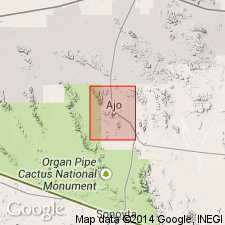
- Usage in publication:
-
- Sneed andesite*
- Modifications:
-
- Named
- Dominant lithology:
-
- Andesite
- AAPG geologic province:
-
- Basin-and-Range province
Summary:
Named for exposures of hornblende andesite north of Dunns Well, near the Sneed ranch in sec 5, T12S, R6W, Pima Co, AZ in the Basin-and-Range province. Locally rests unconformably on Locomotive fanglomerate (new), Chico Shunie quartz monzonite (new), and Cardigan gneiss (new). At south end of Childs Mountain, Sneed is unconformably overlain by Daniels conglomerate (new) and Batamote andesite (new). No type locality designated. Estimated to be about 3,000 feet thick. Mapped (geologic map) at south end of Childs Mountain and northeast of Tule Well in many outcrops. Consists of reddish porphyritic lava. Most of the lava has andesine and green hornblende phenocrysts in an andesitic groundmass. Locally some of the lava contains sericite, epidote, albite, quartz, and chlorite. Has a different relationship (unconformable) to Locomotive fanglomerate than the Ajo volcanics (interfingering). Assigned to the middle? Tertiary.
Source: GNU records (USGS DDS-6; Denver GNULEX).
For more information, please contact Nancy Stamm, Geologic Names Committee Secretary.
Asterisk (*) indicates published by U.S. Geological Survey authors.
"No current usage" (†) implies that a name has been abandoned or has fallen into disuse. Former usage and, if known, replacement name given in parentheses ( ).
Slash (/) indicates name conflicts with nomenclatural guidelines (CSN, 1933; ACSN, 1961, 1970; NACSN, 1983, 2005, 2021). May be explained within brackets ([ ]).

